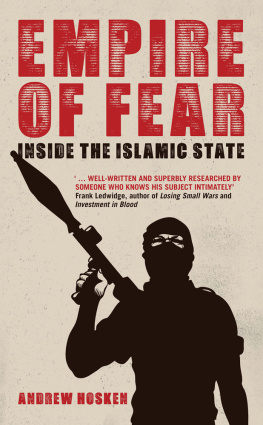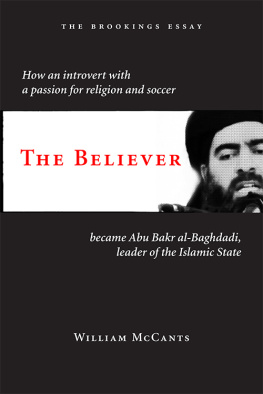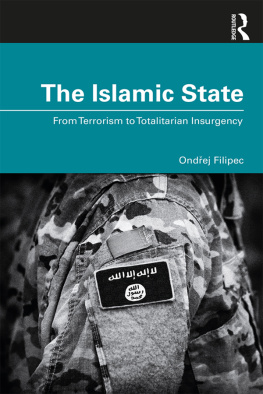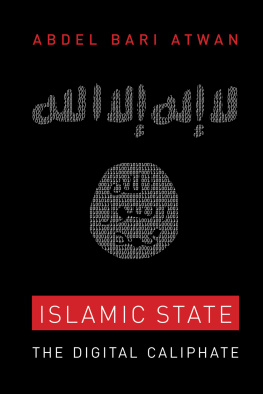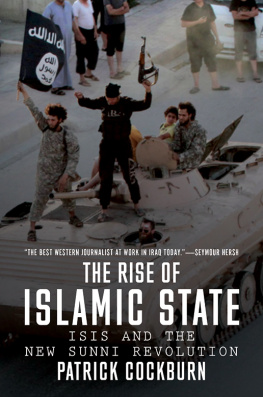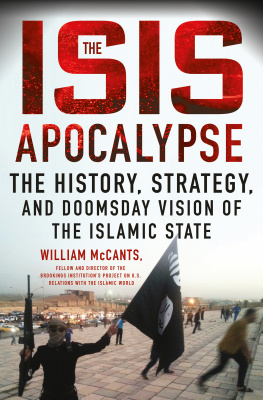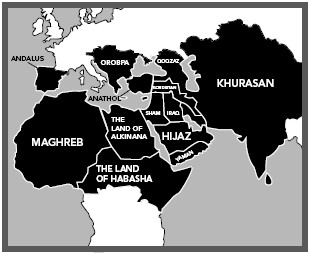
A new world order, as conceived by Islamic State
The face that launched a thousand hits
2014
Baghdad, 5 July 2014
He was either dead or seriously wounded, or so they told us. It had all just happened during an attack by Iraqi security forces on a town called al-Qaim on the Syrian border. For me, working behind the concrete blast walls and barbed wire of the Baghdad office, it all sounded too incredible to be true even in those astonishing days of June and July 2014. But the Iraqi interior ministry was adamant when we called it the worlds most dangerous man was possibly out of action, and for good.
Within a few weeks, Abu Bakr al-Baghdadi seemed to transcend his shadowy role as one of the worlds most wanted terrorists to become a force of nature. Like an avenging fire, he and his thirty thousand jihadis had roared east across the border from Syria into Iraq. They had seized territory that then stretched around 415 miles from eastern neighbourhoods of Aleppo in Syria to the Iraqi town of Sulaiman Bek, which lies just 60 miles from the Iranian border. In a breathtaking move that stunned the world, Mosul, Iraqs second-biggest city, had fallen to Baghdadi. Thousands of Iraqi troops and civilians had been massacred and thrown into shallow graves. Baghdadi now marched on Baghdad itself.
Only six days earlier, on 29 June, Abu Mohammed al-Adnani, Baghdadis bloodthirsty media spokesman, had issued an alarming proclamation. The Islamic State of Iraq and Syria was no longer. ISIS would now be known simply as Islamic State, an entity no longer constrained by the borders of Syria and Iraq. An Islamic empire known as a caliphate was declared and Baghdadi would be the caliph, or khalifah . He was not just some sort of Islamic pope-emperor but the true descendant of Muhammad, second only to the Prophet himself.
Baghdadis full nom de guerre was Abu Bakr al-Baghdadi al-Husseini al-Qurayshi; his real name was also known. He was really Ibrahim Awwad Ibrahim Ali al-Badri al-Samarrai, but with a critical addition. As with his alias, he was also al-Qurayshi, meaning from the Qurayshis. This meant al-Baghdadi was claiming lineage from the tribe of Muhammads own family, known as the Qurayshis, considered by many Islamic scholars and clearly by Islamic State as an essential requirement to be caliph.
This was made by clear by the IS media guru Adnani, who declared:
The khalifah Ibrahim (may Allah preserve him) has fulfilled all the conditions for khilafah [caliph] mentioned by the scholarsHis authority has expanded over wide areas in Iraq and Sham [Syria and Lebanon]. The land now submits to his order and authority from Aleppo to Diyala. So fear Allah, O slaves of Allah! Listen to your khalifah and obey him! Support your state, which grows every day by Allahs grace with honour and loftiness, while its enemy increases in retreat and defeat.
For Muslims there are few more loaded words than khalifah . The historic caliphate is regarded as by far the greatest and most important sovereign institution in the history of Islam and the word appears several times in the plural forms, khulafa and khalaif , and is translated as successors or heirs. In Islam, to any mortal man and there could be no other kind of man there could be no greater honour than to be Muhammads heir.
As we hit the phones to try to confirm what had happened to Baghdadi, the man himself suddenly and dramatically appeared on our television screens. He was attired in the black cloak and turban of the Prophet as he limped his way up the steps to the minbar , Muslims version of a pulpit, at the great mosque of al-Nuri in Mosul. At the top, he greeted his audience of mainly young men in jeans and T-shirts and then sat down and flossed his teeth while waiting for the muezzin to finish the call to prayer.
This was the first time Baghdadi had shown himself to the world on his own terms. Until then all anyone had was the image of a resentful glowering face peering from a prison mug shot. The Iraqi interior ministry, which can often be relied upon for the odd comic touch during many a dark moment, issued a statement, asserting that this baffling figure was indisputably not Baghdadi. Brigadier General Saad Maan, the ministrys well-meaning spokesman, stated confidently, We have analysed the footageand found it is a farce. No farce this, but a recording of Baghdadi from the previous day.
The confusion was perhaps understandable. Despite the terror inflicted by Baghdadi during the last four years, few people knew who he was or what he looked like. It was said he even wore a mask, earning him the nickname the Invisible Sheikh.
Until then, the world had only two mug shots of Baghdadi, taken during his ten months of captivity in a US prison camp, In fact, to be exact, Baghdadi boasted, 6,876 bombings and 1,083 targeted assassinations for the year. This was a man who had not only killed thousands of people; he liked to catalogue his murders and massacres meticulously, for posterity.
From his minbar he called on the Ummah , the term for Muslims around the world, to pay him their allegiance, or bayah : I am the wali [leader] who presides over you, he said, though I am not the best of you, so if you see that I am right, assist me. If you see that I am wrong, advise me and put me on the right track, and obey me as long as I obey God in you. As he spoke, Baghdadis eyes scanned his audience slowly and warily from left to right and back again like searchlights on a prison watchtower.
Since the fifteenth century the sultans of the Ottoman Empire had claimed the title of caliph. In November 1922, a new Turkish assembly dismissed the last sultan and abolished the sultanate, but by a constitutional quirk the title of caliph went to the crown prince, Abdlmecid Efendi, an accomplished artist and avid butterfly collector. Abdlmecid was the 101st Sunni Muslim to claim the caliphate since the death of the Prophet Muhammad in 632 ad. On 3 March 1924, the Turkish assembly abolished the caliphate, and on the following day officials of the new Turkish republic escorted Abdlmecid to the railway station, in what has been described as a humiliating manner, and bundled him onto the Orient Express to Paris and permanent exile. The contrast between the last recognized caliph of the Islamic world and this apparition in Mosul could not have been greater.
Baghdadi had declared a caliphate stretching from the Pyrenees to Indonesia with himself as emperor and head pontiff, effectively world domination, yet the thing that attracted most ridicule from the Western media was his watch, which was either an Omega Seamaster, as worn by James Bond, or a Rolex worn by anyone with 8,000 or so to spare. His hatred for Western values clearly was not all-consuming, but despite this unusual PR glitch, Baghdadi did not cut a ludicrous figure far from it. By then, the TV screens had shown terrifying images of the massacres committed in his name.
Until he launched his war on the world, the Iraq conflict had been a distant memory and the terrible ensuing carnage all too awful to contemplate; the crowds had gone home and so had the foreign troops. For many people in the West, Baghdadi appeared almost as a goblin from a half-forgotten horror story.
For Baghdadi and his predecessors, and for nearly twenty years, the caliphate had been the ultimate goal all along and the reason for all the extraordinary violence they employed against their many enemies. Every atrocity, torture, assassination and theft was simply a means to one overpowering obsession to destroy nation states, seize territory and build a caliphate from the ashes.
Baghdadi had come a long way. In a little more than four years, he had taken a broken gang of jihadis from the brink of complete defeat to the dream they had long cherished: a caliphate at the heart of the Muslim world, governed by Islamic Sharia law and with access to the regions vast oil supplies. Baghdadi had hijacked sectarian uprisings either side of the SyriaIraq border to create his caliphate, and the United States, the UK and governments in the Middle East had been powerless to prevent it. Therefore, rush O Muslims to your state! he exhorted Muslims. Yes, it is your state. Rush, because Syria is not for the Syrians, and Iraq is not for the Iraqis. The earth is Allahs.
Next page
